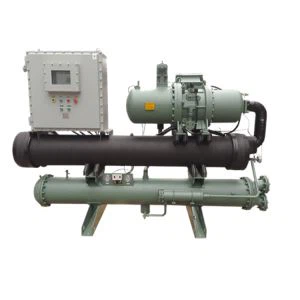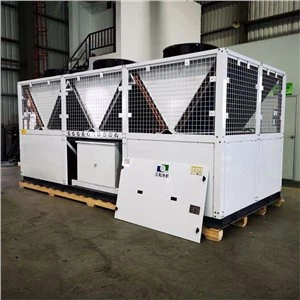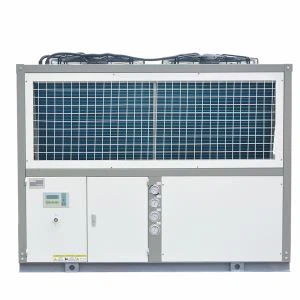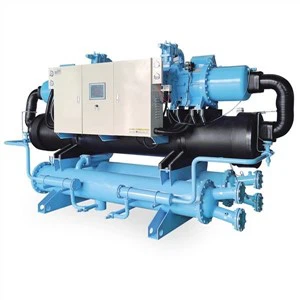Hey there! As a supplier of centrifugal chillers, I've been getting a lot of questions lately about the environmental impact of these nifty machines. So, I thought I'd take a few minutes to break it down for you.
First off, let's talk about what a centrifugal chiller is. Simply put, it's a type of refrigeration system that uses a centrifugal compressor to cool water or other fluids. These chillers are commonly used in large commercial and industrial buildings, like hospitals, hotels, and office complexes, to provide air conditioning and process cooling.
Now, let's dive into the environmental impact. There are a few key areas we need to consider: energy consumption, refrigerant use, and water usage.
Energy Consumption
One of the biggest environmental impacts of any chiller is its energy consumption. Centrifugal chillers are generally more energy - efficient than some other types of chillers, like reciprocating chillers. This is because centrifugal compressors can handle large volumes of refrigerant with relatively low energy input.
Modern centrifugal chillers are designed with advanced technologies, such as variable - speed drives. These drives allow the compressor to adjust its speed based on the cooling load. So, when the demand for cooling is low, the compressor runs at a slower speed, using less energy. This kind of energy - saving feature is a huge plus for the environment. It means less electricity is being generated, which in turn reduces the emissions from power plants. Power plants often burn fossil fuels like coal, natural gas, and oil, and these emissions contribute to air pollution and climate change. By using a more energy - efficient centrifugal chiller, we can help cut down on these harmful emissions.
However, it's important to note that the actual energy efficiency of a centrifugal chiller depends on a few factors. The size of the chiller, the operating conditions, and how well it's maintained all play a role. If a chiller is too big for the cooling load it needs to handle, it may run inefficiently. And if it's not properly maintained, things like dirty coils or low refrigerant levels can also reduce its efficiency.


Refrigerant Use
Refrigerants are another important aspect when it comes to the environmental impact of centrifugal chillers. In the past, many chillers used refrigerants called chlorofluorocarbons (CFCs) and hydrochlorofluorocarbons (HCFCs). These refrigerants were great at cooling, but they had a major drawback. They were found to be ozone - depleting substances. When released into the atmosphere, they could break down the ozone layer, which protects the Earth from harmful ultraviolet radiation.
Thankfully, we've come a long way since then. Most modern centrifugal chillers use hydrofluorocarbons (HFCs) as refrigerants. HFCs don't deplete the ozone layer, but they do have a high global warming potential (GWP). GWP is a measure of how much heat a greenhouse gas traps in the atmosphere over a specific period compared to carbon dioxide.
To address this issue, the industry is constantly working on developing new, more environmentally friendly refrigerants. Some of these new refrigerants have a much lower GWP, which means they have a smaller impact on climate change. As a supplier, we're always looking to offer chillers that use these more sustainable refrigerants.
It's also crucial to handle refrigerants properly. Leaks can release these potent greenhouse gases into the atmosphere. That's why regular maintenance and refrigerant leak detection are so important. If a leak is detected early, it can be fixed quickly, preventing unnecessary emissions.
Water Usage
Centrifugal chillers typically use water for cooling purposes. They can be either air - cooled or water - cooled. Water - cooled chillers are more common in large commercial applications because they are generally more energy - efficient. However, they do use a significant amount of water.
The water used in a water - cooled chiller is often taken from a local water source, like a river or a well. After it's used for cooling, the water is usually discharged back into the environment. But before it's discharged, it needs to be treated to remove any contaminants.
One way to reduce the water usage of a water - cooled chiller is to use a closed - loop system. In a closed - loop system, the water is recycled and reused within the chiller. This reduces the amount of fresh water that needs to be taken from the environment. Another option is to use a cooling tower that is designed to be more water - efficient. These cooling towers can evaporate less water, which also helps conserve water resources.
Comparing with Other Chillers
Let's take a quick look at how centrifugal chillers stack up against some other types of chillers in terms of environmental impact.
- Water Cooled Scroll Chiller for Air Condition Host: You can check out more details about Water Cooled Scroll Chiller for Air Condition Host. Scroll chillers are generally used for smaller applications compared to centrifugal chillers. They are often less efficient when it comes to large - scale cooling. Centrifugal chillers can handle much larger cooling loads with better energy efficiency in big commercial and industrial settings.
- Magnetic Bearing Centrifugal Chiller with Hanbell Compressor: If you're interested in a more advanced type of centrifugal chiller, have a look at Magnetic Bearing Centrifugal Chiller with Hanbell Compressor. These chillers use magnetic bearings, which reduce friction and increase energy efficiency even further. They also tend to have a longer lifespan and require less maintenance compared to some other chillers.
- Screw Compressor Chiller: Screw Compressor Chiller is another option. Screw chillers are known for their reliability and can handle a wide range of cooling loads. However, in terms of energy efficiency for very large cooling loads, centrifugal chillers usually have an edge.
Conclusion
In conclusion, centrifugal chillers have both positive and negative environmental impacts. On the plus side, they are generally energy - efficient, especially when equipped with modern technologies like variable - speed drives. And the industry is making great strides in developing more environmentally friendly refrigerants. On the other hand, there are still challenges, such as refrigerant management and water conservation.
As a supplier, we're committed to providing our customers with the most environmentally friendly centrifugal chillers possible. We work closely with manufacturers to ensure that the chillers we offer meet the highest standards of energy efficiency and environmental sustainability.
If you're in the market for a chiller and are concerned about the environmental impact, we'd love to talk to you. We can help you choose the right chiller for your needs, whether it's a centrifugal chiller or another type. Contact us to start a discussion about your cooling requirements and how we can help you make a more environmentally conscious choice.
References
- ASHRAE Handbook - Refrigeration. American Society of Heating, Refrigerating and Air - Conditioning Engineers.
- "Refrigeration and Air Conditioning Technology" by William C. Whitman, William M. Johnson, and John Tomczyk.






